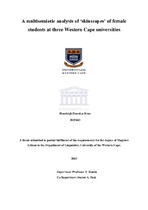| dc.description.abstract | This study used a multisemiotic/multimodal discourse analysis approach to analyze tattoos of selected female students at three Western Cape Universities: the University of the Western Cape (UWC), the University of Cape Town (UCT), and Stellenbosch University (SUN). This study looked at the popular cultural practice of tattooing as a site for identity formation. The aim of this research project was to establish how popular culture is semiotized and resemiotized on corporeal landscapes. The focus was on the kind of semiotics that female students draw on when getting their tattoos, and also where they put these tattoos. The researcher intended to investigate the semiotics of female bodies within the broader field of linguistic landscaping, with a specific look at corporeal linguistic landscapes (Peck & Stroud, 2015). This research was also interested in establishing whether the historical background of each university has an influence on the student population, and subsequently, the tattoos they choose to inscribe on their bodies. This study sought to answer whether there are similarities and/or differences in the tattoos the participants chose across the different campuses and to what effect the social context affects the type of tattoos they chose. All participants were selected via purposive sampling. This means that only those with visible tattoos were
approached, as they met the criteria described above (cf. Patton, 1990; Kumar, 1999). Methodologically, interviews as well as text data collection were used to collect the data. In addition, a multimodal text analysis was used as the tattoos were read as texts. Among others, the findings indicated that female participants negotiate their femininity by acquiring traditionally feminine tattoo designs, relatively small in size, which are typically placed where they can be concealed easily. This in contrast with male tattoo designs which tend to be bigger and more visible. It was found that there was preference for solitary texts designs across the three campuses followed by a combination of text and image. In terms of agency, it was found that participants were agentive by being able to control who read and
how others read their bodies. The study concludes that women are mindful of their female identity when they choose the designs, sizes and placements of their tattoos. It was found that they typically defy social norms through getting tattoos, but at the same time adhere to social (and feminine) norms by using small tattoos emplaced in hidden body spaces. This means there is a restriction on who is allowed to consume the tattoos. This study adds to a deeper understanding of tattooing as popular culture at universities in post-apartheid South Africa. It also contributes to recent development in corporeal linguistic landscapes studies. In turn, it offers a profound understanding of the concept of ‘skinscapes,’ which allows for a deeper understanding of how female bodies are ‘authored’ by the tattooee
as well as how they are ‘read’ and consumed by onlookers. | en_US |

